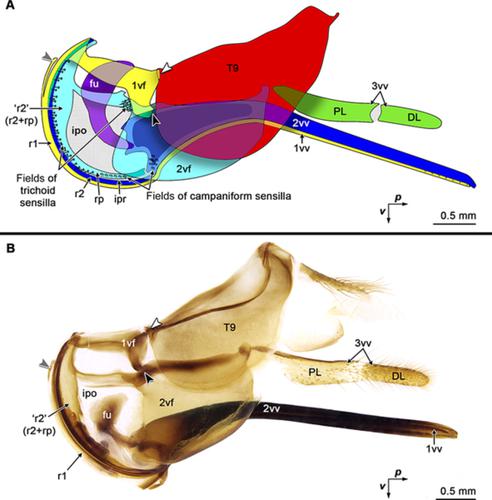当前位置:
X-MOL 学术
›
Entomol. Sci.
›
论文详情
Our official English website, www.x-mol.net, welcomes your feedback! (Note: you will need to create a separate account there.)
Sting morphology of the European hornet, Vespa crabro L., (Hymenoptera: Vespidae) re‐examined
Entomological Science ( IF 0.9 ) Pub Date : 2020-10-07 , DOI: 10.1111/ens.12438 Halyna Stetsun 1 , Natalia A. Matushkina 2
Entomological Science ( IF 0.9 ) Pub Date : 2020-10-07 , DOI: 10.1111/ens.12438 Halyna Stetsun 1 , Natalia A. Matushkina 2
Affiliation

|
The European hornet Vespa crabro L. (Hymenoptera: Aculeata: Vespidae) is considered the largest native vespid wasp in Europe. The females use their sting to defend themselves and the colony. Despite a long history of research, the morphology of the sting in V. crabro remains insufficiently studied. Here, we provide a detailed description of the sting of V. crabro revealed with light microscopy, scanning electron microscopy and confocal laser scanning microscopy. Shape and sculpture of sting sclerites, sensilla of different morphotypes and peculiarities of the cuticle autofluorescence are combined to discuss the functional and phylogenetic significance of the sting characters in Aculeata.
中文翻译:

重新检查欧洲大黄蜂(Vespacrabro L.)(膜翅目:胡蜂科)的螫刺形态
欧洲大黄蜂 Vespacrabro L.(膜翅目:Aculeata:Vespidae)被认为是欧洲最大的本土黄蜂。雌性用它们的刺来保护自己和殖民地。尽管研究历史悠久,但对 V.crabro 螫刺的形态研究仍不够充分。在这里,我们详细描述了用光学显微镜、扫描电子显微镜和共聚焦激光扫描显微镜揭示的 V.crabro 的刺痛。结合刺骨的形状和雕刻、不同形态类型的感受器和角质层自发荧光的特性,讨论了刺螈的刺状特征的功能和系统发育意义。
更新日期:2020-10-07
中文翻译:

重新检查欧洲大黄蜂(Vespacrabro L.)(膜翅目:胡蜂科)的螫刺形态
欧洲大黄蜂 Vespacrabro L.(膜翅目:Aculeata:Vespidae)被认为是欧洲最大的本土黄蜂。雌性用它们的刺来保护自己和殖民地。尽管研究历史悠久,但对 V.crabro 螫刺的形态研究仍不够充分。在这里,我们详细描述了用光学显微镜、扫描电子显微镜和共聚焦激光扫描显微镜揭示的 V.crabro 的刺痛。结合刺骨的形状和雕刻、不同形态类型的感受器和角质层自发荧光的特性,讨论了刺螈的刺状特征的功能和系统发育意义。


























 京公网安备 11010802027423号
京公网安备 11010802027423号